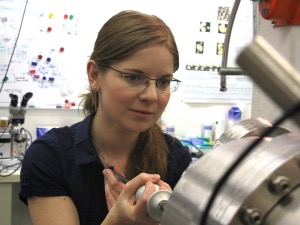/ News, Portraits
ascinated by Playing with Individual Atoms

Even at school, Sylwia Nowakowska was fascinated by the idea of controlling individual atoms. Today, as a doctoral student at the Nanolab run by Professor Thomas Jung, this is exactly what she’s doing. She condenses xenon atoms in quantum wells and examines how their arrangement in the quantum wells changes according to the number of atoms and how the quantum wells communicate with one another. For Sylwia, this is a childhood dream come true. Despite the fascination this basic scientific work holds for the young doctoral student, she sees her long-term future in industry, working on applied research topics. At the moment, however, she is dedicated to her research and is successfully tackling the basics of physical bonds in the Department of Physics at the University of Basel.
The path to physics
Sylwia Nowakowska comes from Bytów in Poland and studied technical physics in Posen. However, it was not her physics lessons at school that inspired her and led her to study the subject, but articles about nanotechnology. She was immediately fascinated by the possibilities of “playing” with atoms. In 2007, when the time came to choose a subject for her studies, it was the nanosciences that interested Sylwia most. At that time, however, nanosciences were only available in Poland at an advanced level, and Sylwia therefore opted for technical physics to begin with. She received an interdisciplinary education in physics, chemistry, mathematics and engineering and gained insights into industrial applications from an early stage.
Master’s in the Nanolab
While studying for her Master’s, she completed several internships, including one at the Leibniz Institute for Innovative Microelectronics in Frankfurt. “I actually wanted to write my Master’s thesis in Frankfurt, but the supervising professor became sick, so my plans fell through,” recalls Sylwia. Together with her husband, Jan Nowakowski, who is also a physicist and nanoscience researcher, she began looking for a new destination. The couple found what they were hoping for in the laboratory of Professor Thomas Jung, who (as titular professor) is supported by the SNI and leads a research group at the Paul Scherrer Institute and at the Department of Physics at the University of Basel. Sylwia completed her Master’s thesis here on the polymorphism of two-dimensional, self-assembling layers and made such a good impression that Thomas Jung recruited her as a doctoral student in 2012.
Success in the second project
The 27-year-old physicist has now been working on her doctorate in the Nanolab in Basel since July 2012. After a first project failed after eight months, everything is now running smoothly. Sylwia is now investigating the properties of molecular structures on surfaces that assemble themselves in a bottom-up process. In January, she was the lead author on a paper in Nature Communications outlining the initial results. In the work presented, Sylwia was able to demonstrate how xenon atoms condense in quantum wells. The quantum wells organize themselves on a substrate surface made from specifically “programmed” molecules. They serve as measuring beakers with a precisely defined size, form and atomic structure of the base and walls. With the aid of scanning tunneling microscopy, Sylwia was able to show that the xenon atoms always arrange themselves according to a specific principle. The results also suggest that the electronic state of individual quantum wells depends not only on the number of xenon atoms, but also on the number of xenon atoms in the neighboring wells. “This shows that electrical communication takes place between the quantum wells,” states Sylwia, explaining her latest findings, which is she currently compiling for another publication.
Happy to stay longer in Switzerland
Speaking to Sylwia, it is clear just how fascinated she is by her research. In the long term, however, she sees herself working in research and development at an industrial company rather than a university. To ensure that she is perfectly prepared for this step, she also took part in last year’s Antelope careers program at the University of Basel. In particular, the in-depth discussions with an HR representative and a mentor from Novartis gave Sylwia plenty of important information. She now feels well prepared to find a position in industry upon completing her doctorate. She would be happy to remain in Switzerland because she is very fond of the mountains and the outdoors, which offer a perfect counterbalance to her laboratory work, “playing” with atoms.
